Rosh Hashanah Love Letters: Illuminations of David Moss
How should we approach Hashem at this time of teshuvah? Surely with fear because we understand that our lives hang in the balance. But another element needs to be incorporated. Love. Yes, love must define our relationship with the Merciful One as we declare on Yom Kippur: “For we are Your people and You are our God… we are Your friend and You are our Beloved.”
So it is entirely appropriate that we consider one of the most beautiful expressions of the earthly love relationship in David Moss’s Love Letters: A Celebration of Jewish Love and Marriage in Words and Images. It is a special edition book that presents approximately 55 of Moss’s illuminated ketubot out of the hundreds he has created over the last thirty-five years. Each one is accompanied by detailed images, translations of the additional texts Moss has woven into the ketubah and accompanying letters Moss wrote to his clients that reveal his creative process with each couple. And why would we want to look at someone else’s marriage contract? Because under Moss’s expert hand each ketubah is a work of art that comments on the most sacred relationship a human being can have. Each is rooted in Torah and Jewish values and provides a pretty good starting point for our love relationship with our God.
Moss is best known for his Moss Haggadah, first commissioned in 1983, that has become a staple of contemporary illuminated haggadot. Elaborate in its creative and lush use of Hebrew calligraphy it has been widely reproduced by his publisher Bet Alpha Editions. Other illuminated works include the Alphabet of the Angel Metatron, Offering of Peace, The Song of David, and prints of Judaic images in the style of Pueblo Southwest Indian pottery which he also makes. Additionally he has completed many collaborative projects including Song of Songs, The Book of Lamentations, The Book of Jonah, a program of Judaic space design for building projects and the remarkable Tree of Life Shtender that combines in a hand-made piece of furniture every ritual object needed for Jewish observance throughout the year.
In spite of all these achievements Moss may well be best remembered for his ketubot. Director of the Israel Museum, James S. Snyder comments that Moss “has made a major contribution to the revival of the tradition of the [illuminated] ketubah…” We have many fine historical examples of ketubot elaborately decorated with beautiful and complex borders but in the 20th century more and more couples turned to printed versions with a minimum of decoration and no unique additions by Jewish artists. With Moss’s work starting in the 1970s that has changed and an ancient Jewish art form has been reborn.
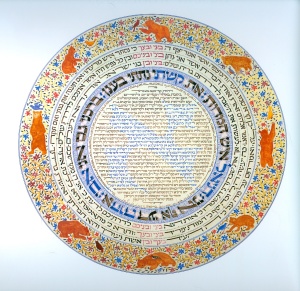
In this book Moss has divided these ketubot into seven categories; Human Wholeness, Love, The Matching of Souls, The Dance of Courtship, Anticipation, The Wedding and Marriage. From the first category the Alpert Ketubah stands out as a fairly traditional format. The text (ketubah d’irchesah because it commemorates the couple’s 18th anniversary) is in the center surrounded by verses that incorporate each of their children’s names while the little bears playing with birds on the border alludes to the couple’s name, Dov and Zipporah. The notion of unity and beginning is emphasized by the aleph created by two different colors of ink used for the main text. What becomes immediately noticeable is the three-fold repetition of bein u’bein…between and between…in red that dominates the circular text top and bottom. This double declaration stresses that “all relationships constantly and simultaneously moves in both directions and at the same time strongly merges the two subjects.”
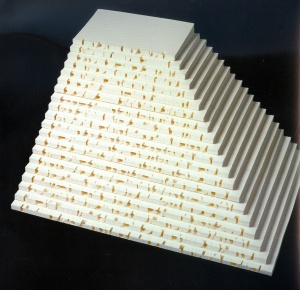
Radically different is the Arnovitz Ketubah that stands as a 20” pyramid sculpture of 20 cut blank books in paper. Along one stepped façade the traditional ketubah text is a paper-cut text written with the top half of the letter on the horizontal surface and the bottom half cut into the vertical surface. As one opens the books one by one two paper-cut texts appear: Maimonides’ eight steps of Tzedakah from Mishnah Torah and then the Baraita of Rabbi Pinchas Ben Yair (Avodah Zarah 20b) that lists twelve steps of Jewish spiritual elevation. Clearly a very different kind of 20th anniversary ketubah, this one emphasizes two essential elements of our loving approach to God; Tzedakah and Teshuvah.
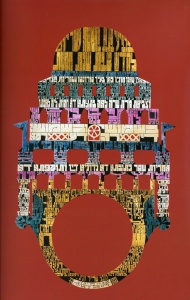
Equally unusual is the Shainhouse Ketubah. When Moss first unrolled the animal skin parchment prepared for this ketubah there was small hole in it, a natural flaw. This inspired him to create their ketubah in the shape of the traditional “City of Gold” wedding rings communally used in Central Europe for hundreds of years. The colored inks and gold leaf spell out the ketubah text inscribed on the cut-out parchment ring-like surface. The structure that crowns the ring of course alludes to Jerusalem, City of Gold, and “the new home the couple was about to build.” From this foundation we can learn that in our love for God we must create a sacred earthly home for Him to join us in.
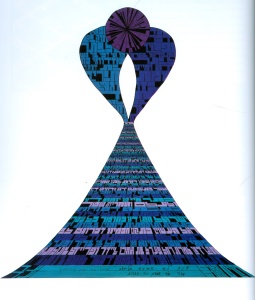
The Goldberg Ketubah brings us to the conceptual frontier of what is possible in illuminating a simple marriage contract. Evidently the couple sent Moss a midrash from the Zohar that inspired them. His reaction was dramatic, creative and brilliant. “Each spirit-soul, prior to its entering into this world, consists of both male and female united into one being. When it descends to this earth, the two parts separate and each comes to animate a different body. At the time of marriage, the Holy One, Blessed be He, Who knows all souls and spirits, unites them again as they were before….” Moss inscribed this midrash in the upper circle (the united being) and the separate shapes that converge at the point at which the ketubah begins, ”On the fifth day of the week…” thus visually fulfilling the midrashic vision of ultimate unity of male and female in Jewish marriage.
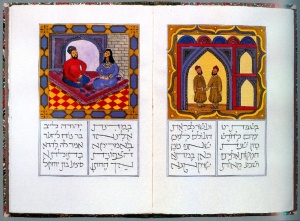
As the reader can see, Moss’s ketubot are both for newly married couples and couples commemorating many years of marriage. By creating such a new form (artistically at least, I have no idea the halachic validity of a commemorative ketubah), Moss enriches the creative possibilities of the ketubah, introducing a narrative element in what is essentially a simple financial guarantee of support for the wife. The Blackman Ketubah, celebrating 25 years of marriage, is such a narrative document. It is a seven-page leather bound book based on a Persian ketubah model starting with a carpet page that illuminates the first word of the text. The next pages depict in simple Persian miniature style the identity and betrothal of the couple, the building of a new home and images of their children. This introduction of a visual narrative into the legal document effectively becomes a commentary on the entire marital process itself.
David Moss’s visual creativity, depth of textual scholarship and courage in pushing the boundaries of traditional forms mark him as a master of this newly revived Jewish art. Cleverness in matching image, text and individuals has always been the hallmark of ketubah illumination. What is unusual here is when the visual becomes a commentary on the text and a creator of independent meaning that enlarges our understanding of the goals of Jewish marriage and our ultimate striving to cleave in love to our God.
Love Letters by David Moss
Bet Alpha Editions, Berkeley, CA
www.bet-alpha-editions.com